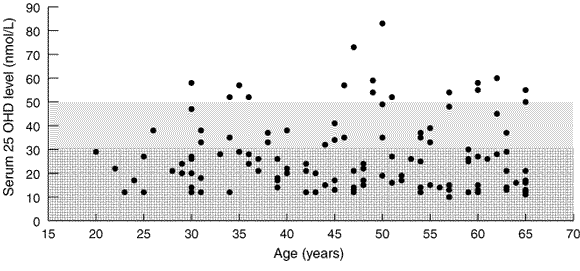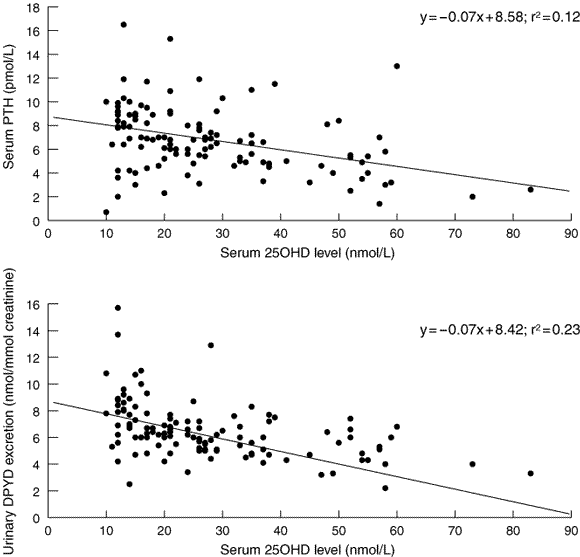Chronic vitamin D deficiency may lead to osteomalacia and/or osteoporosis, with an increased risk of fragility fractures.1 In Australia, with its multicultural population, a resurgence of vitamin D deficiency has been noted recently.2 While there are reports of abnormalities in vitamin D metabolism in Muslim women,3,4 there are no published data on fracture rates, bone mass measurements or bone turnover rates in this cohort. We aimed to determine the effect of vitamin D deficiency on bone turnover in Muslim women.
Muslim women aged 20–65 years were invited to participate in our study through a pamphlet questionnaire, which was distributed in shopping centres and mosques in south-western Sydney in November 1999 to April 2000. We used a simple format with "yes or no" answers to obtain details about their (i) dress (whether they were veiled during daily outdoor activities), (ii) sun exposure (defined as more or less than 60 minutes of daily, outdoor sunlight exposure per week), and (iii) menopausal status. They were also asked to donate venous blood and to collect an early-morning, two-hour urine sample for analysis. Recruitment was undertaken during the summer months.
We excluded from the study women who refused phlebotomy, had chronic medical disorders or were receiving medications that could interfere with bone turnover. Informed consent was obtained from all participants. Our study conformed with the National Statement on Ethical Conduct in Research Involving Humans (National Health and Medical Research Council Guidelines).5
One hundred and nineteen of 146 Muslim women met the inclusion criteria. Seven women refused phlebotomy, 12 had chronic medical disorders, and eight were taking medications that could interfere with bone turnover. Their mean age was 46.6 (1.1) years, with 49 (41.2%) being postmenopausal. Eighty-nine (75%) were veiled and 50 (42%) stated that they were exposed to more than 60 minutes of sunlight per week.
Eighty-one women (68.1%) showed evidence of "severe" vitamin D deficiency (Box 1). The women with severe vitamin D deficiency had significantly higher serum PTH levels (7.3 [0.3] v 5.4 [0.5] pmol/L; P = 0.001) and higher urinary DPYD excretion rates (7.2 [0.3] v 5.4 [0.2] nmol/mmol creatinine; P = 0.003) than women with serum 25OHD levels ≥ 30 nmol/L. No significant differences were seen with respect to their ages, menopausal status, and serum calcium, phosphate and alkaline phosphatase levels. Wearing a veil or the amount of sunlight exposure did not correlate with serum 25OHD levels.
Fifty-five (46.2%) Muslim women were found to have elevated urinary DPYD excretion rates. These women had significantly lower serum 25OHD (18.9 [1.2] v 31.5 [1.8] nmol/L; P = 0.001) and higher serum PTH (8.5 [0.9] v 5.9 [0.3] pmol/L; P = 0.003) levels than women with a urinary DPYD excretion rate ≤ 6.5 nmol/mmol creatinine. After controlling for age and menopausal status, the risk of developing high bone turnover was significantly greater in women with severe vitamin D deficiency (relative risk = 5.52; 95% CI, 2–14.8; χ2 = 12.95; P = 0.0003).
Hyperparathyroidism occurred in 46 (38.6%) women. Box 2 shows the correlations between serum 25OHD levels and PTH levels, and urinary DPYD excretion rates. An elevation in urinary DPYD excretion occurred when the serum 25OHD level was < 30 nmol/L.
In a cohort of "healthy" Muslim women living in an urban Sydney community, we found severe vitamin D deficiency in 68%, hyperparathyroidism in 38.6% and high bone turnover in 46%.
In white women, vitamin D deficiency has been shown to correlate with low bone mass and to often be present in those with hip fractures.6 Biochemical evidence of hyperparathyroidism has been reported in white women with serum 25OHD levels < 30 nmol/L.7 In our study, serum 25OHD level was the most important predictor of serum PTH level. In Lebanese women, a gradual increase in PTH level has been found, with lower serum 25OHD levels below 25 nmol/L.3
The importance of high bone turnover, as measured by the new non-invasive markers of bone turnover, has been confirmed in large clinical trials.8 Urinary DPYD excretion rate is a sensitive marker of bone resorption and has been shown to correlate significantly with serum 25OHD levels and fracture risk.9 In our study, Muslim women had a 5.5-times greater risk of developing high bone turnover if severe vitamin D deficiency was evident. A gradual increase in urinary DPYD excretion rate was observed in women with lower serum 25OHD levels below 30 nmol/L. A similar relationship between vitamin D deficiency and urinary DPYD excretion rate has been found in other studies.10
The aetiology of vitamin D deficiency in our cohort was multifactorial beyond a lack of ultraviolet light exposure, with dietary differences and skin pigmentation affecting UV absorption being other possible factors. However, neither lack of sunlight exposure nor veiling correlated with serum 25OHD levels. Our questionnaire, with only a "yes or no" format, was very simplistic. More detailed studies are required to unravel the cause of the vitamin D deficiency in this cohort.
In conclusion, we have shown that high bone turnover, as demonstrated by elevated urinary DPYD excretion rates, occurs in Muslim women with vitamin D deficiency. Detailed studies evaluating bone densitometry and fracture risk in this cohort are needed.
Received 26 November 2001, accepted 2 April 2002
- Terrence H Diamond1
- Sherel Levy2
- Angelina Smith3
- Peter Day4
- St George Hospital Campus, University of New South Wales, Sydney, NSW.
None identified.
- 1. Parfitt AM. Osteomalacia and related disorders. In: Avioli L, Krane S, editors. Metabolic bone disease and clinically related disorders. 2nd ed. Philadelphia: W B Saunders, 1990: 329-396.
- 2. Mason RS, Diamond TH. Vitamin D deficiency and multicultural Australia. Med J Aust 2001; 175: 236-237. <eMJA full text>
- 3. Gannage-Yared MH, Chemali R, Yaacoub N, Halaby G. Hypovitaminosis D in a sunny country: relation to lifestyle and bone markers. J Bone Miner Res 2000; 15: 1856-1862.
- 4. El-Sonbaty MR, Abdul-Ghaffar NU. Vitamin D deficiency in veiled Kuwaiti women. Eur J Clin Nutr 1996; 50: 315-318.
- 5. National Health and Medical Research Council. National Statement on Ethical Conduct in Research Involving Humans. Canberra: NHMRC, 1992. Available at: http://www.health.gov.au/nhmrc/publications/synopses/e35syn.htm (accessed July 2002).
- 6. Morris HA, Morrison GW, Burr M, et al. Vitamin D deficiency and femoral neck fractures in elderly South Australian women. Med J Aust 1984; 140: 519-521.
- 7. McKenna MJ, Freaney R. Secondary hyperparathyroidism in the elderly: means to defining hypovitaminosis D. Osteoporos Int 1998; Suppl 8: S3-S6.
- 8. Delmas PD, Eastell R, Garnero P, et al. The use of biochemical markers of bone turnover in osteoporosis. Osteoporos Int 2000; Suppl 6; S2-S17.
- 9. Garnero P. Markers of bone turnover for the prediction of fracture risk. Osteoporos Int 2000; Suppl 6: S55-S65.
- 10. Brazier M, Kamel S, Maamer M, et al. Markers of bone remodeling in the elderly subject: effects of vitamin D insufficiency and its correction. J Bone Miner Res 1995; 10: 1753-1761.







Abstract
Objective: To measure bone turnover in Muslim women with vitamin D deficiency.
Design: A cross-sectional study of a random sample of Muslim women aged 20–65 years, evaluated over a 6-month period from November 1999 to April 2000.
Setting and participants: 146 women living in an urban community in south-western Sydney with adequate opportunities for sun exposure.
Main outcome measures: Bone turnover as measured by urinary deoxypyridinoline (DPYD) excretion rates; and vitamin D status as determined by 25-hydroxyvitamin D (25OHD) levels, serum calcium levels and parathyroid hormone (PTH) concentrations.
Results: We analysed data on 119 Muslim women (mean [SEM] age, 46.6 [1.1] years) who met the inclusion criteria. There were 81 (68.1%) women with serum 25OHD levels < 30 nmol/L (defined as "severe" vitamin D deficiency). Fifty-five (46.2%) women had evidence of high bone turnover (urinary DPYD excretion > 6.5 nmol/mmol creatinine). The women with "severe" vitamin D deficiency had significantly higher serum PTH levels (7.3 [0.3] v 5.4 [0.5] pmol/L; P = 0.001) and higher urinary DPYD excretion (7.2 [0.3] v 5.4 [0.2] nmol/mmol creatinine; P = 0.003) than women with serum 25OHD levels ≥ 30 nmol/L. No significant differences were seen in their ages, menopausal status or serum calcium and phosphate measurements. The risk of developing high bone turnover was significantly greater in the women with "severe" vitamin D deficiency (relative risk = 5.52; 95% CI, 2–14.8; χ2 = 12.95; P = 0.0003).
Conclusion: High bone turnover occurs in Muslim women with vitamin D deficiency.